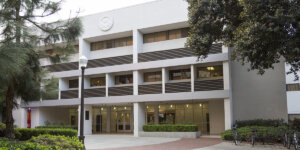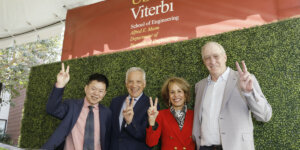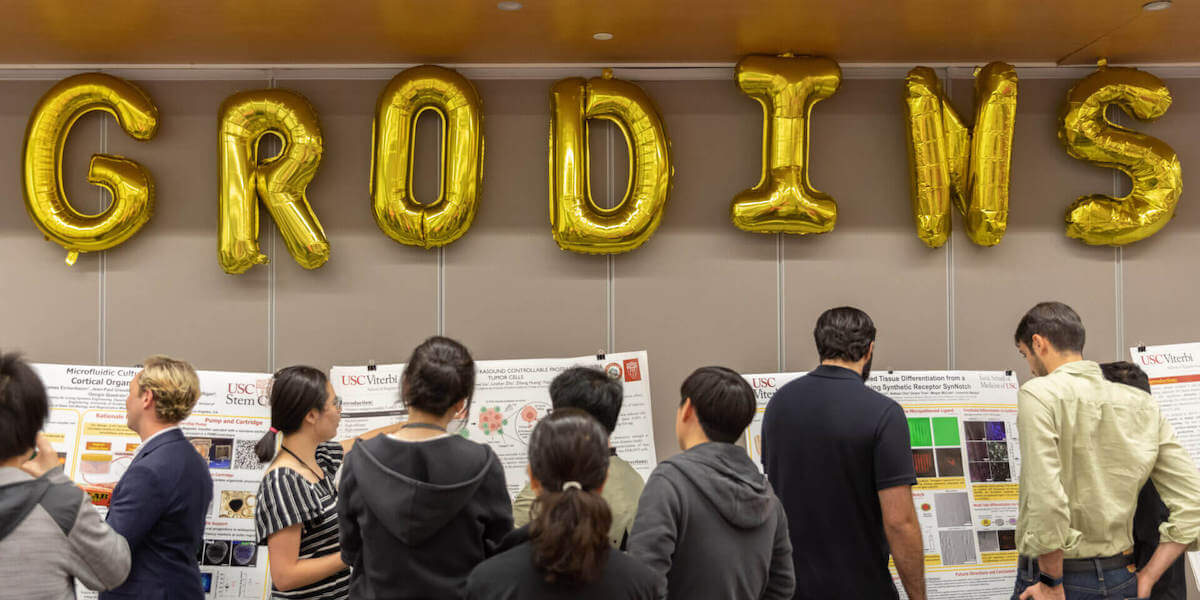
The Alfred E. Mann Department of Biomedical Engineering celebrated the 25th Anniversary of the Grodins Symposium in 2023. Image/Colin Huang.
From brain stimulation devices to uterus-on-a-chip technology – the 2023 Grodins Research Symposium shone a spotlight on the broad spectrum of USC Viterbi biomedical engineering undergraduate and graduate student research.
Over 130 students and faculty gathered at the USC Michelson Center for Convergent Bioscience in April to celebrate the 25th anniversary of the annual symposium, named after USC Professor Fred S. Grodins (1915-1989), a pioneer in the field who established the biomedical engineering program at USC.
The event featured 74 research poster presentations and eight featured podium presenters. It was the first symposium since the announcement of the historic naming of the Alfred E. Mann Department of Biomedical Engineering, and the first time the event was held entirely in-person since before the pandemic.
Chonette Chair in Biomedical Technology and Professor of Biomedical Engineering David D’Argenio oversaw the inaugural Grodins Symposium while he was Department Chair. D’Argenio said the event was established for students to gain invaluable experience effectively communicating their research to people who may not be directly working within their area.
“It’s a skill that’s essential, especially for biomedical engineering students, because they will be involved with large interdisciplinary groups wherever they go,” D’Argenio said. “There will be clinicians, electrical engineers — the whole spectrum. So it’s important that the biomedical engineering students learn how to summarize their work succinctly and explain it carefully and understandably to a diverse audience.”
D’Argenio said when the department established the event, it was unique in that it was organized entirely by biomedical engineering students, with a coordinating team responsible for the program – from fundraising to marketing and coordination of guest speakers.
“I think we initially had around 20 Ph.D. students involved. They were in charge of it from beginning to end, and it’s great to see how much it has grown and matured dramatically over the years,” D’Argenio said.
Executive Chair of the 2023 event, Natalie Khalil, said this year’s symposium was an excellent opportunity for the department to come together over a shared appreciation for scientific research and emerge as a more closely-knit community.
“In addition to building community, the symposium is also a great way for students to stay up to date on the research happening on campus,” Khalil said. “Since the field of biomedical engineering is so interdisciplinary, this is really important because it can provide students with exposure to ideas slightly outside of their own scope of research, which can provide them with inspiration for new research avenues or allow them to push the boundaries of their own projects.”
The symposium included a keynote address from UC Irvine Chancellor’s Professor in Biomedical Engineering Abraham Lee. Lee — who is also director of the NSF I/UCRC Center for Advanced Design and Manufacturing of Integrated Microfluidics — gave a presentation about vein-to-vein microfluidic engineering for cell therapies.
Khalil’s fellow Executive Chair Yuanzhong Pan said guest speakers, including Lee, allowed students to enhance their understanding about the broad career options open to them beyond their Ph.D.
“I would say the highlight for students is that it’s not only about being a biomedical engineer today, but also being a biomedical engineer tomorrow,” Pan said.
Brain stimulation device takes podium award
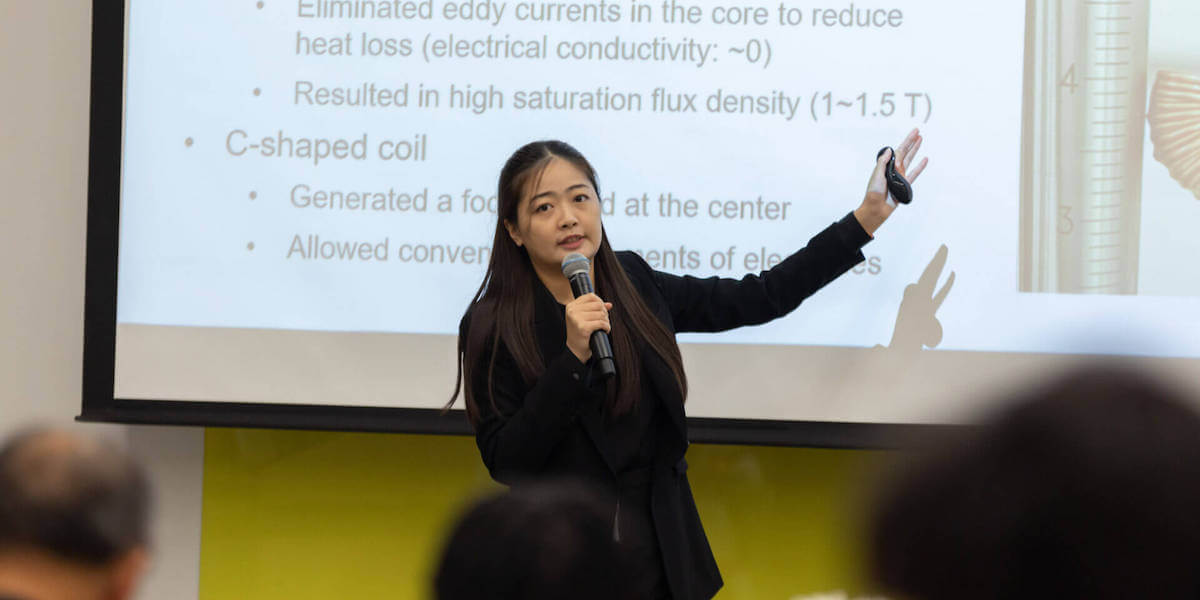
Grodins Podium Award Winner Wenxuan Jiang presents her research at the symposium. Image/Colin Huang
A miniaturized magnetic stimulation coil to better understand how humans can benefit from cutting-edge brain stimulation treatments was named the podium presentation winner at the symposium. Ph.D. student in the USC Neural Modeling and Interface Lab Wenxuan Jiang created the miniaturized transcranial magnetic stimulation (TMS) coil, which she said was designed to open new possibilities in the field of neuromodulation.
“Despite the widespread use of TMS for treating neurological and neuropsychiatric conditions such as depression, obsessive-compulsive disorder, and migraine, the underlying mechanisms of its effects remain largely unclear,” Jiang said. ”Animal models are essential for investigating such underlying mechanisms since they allow more comprehensive examinations and invasive experiments that are difficult or impractical on humans. However, most commercial TMS coils are designed for humans.”
Jiang said there was a strong need for miniaturized TMS coils for neuroscience, neural engineering, and clinical research applications. Her team’s coil aims to meet that need — being compact, affordable and portable, without compromising stimulation efficiency.
“The applications for this device could be vast, including potential use in clinical settings for the treatment of neurological and neuropsychiatric disorders, and in research settings for studying the neural mechanisms underlying TMS in small animal models,” Jiang said.
Jiang said the symposium experience provided an excellent platform to share and discuss your research with fellow students and experts in the field, and to receive invaluable feedback. To be named podium winner was icing on the cake for Jiang.
“It was a truly humbling moment. The recognition means a lot to me, and it also attests to the potential impact of our research on the field of biomedical engineering,” Jiang said.
Grodins Symposium award winners
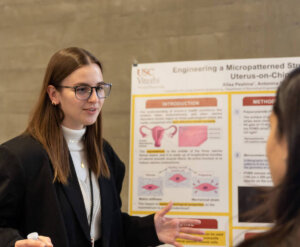
Top 1st Year award winner Alisa Peshina discusses her research at the Grodins Symposium. Image/Colin Huang
Podium Winner:
- Wenxuan Jiang: A C-Shaped Miniaturized Coil for Transcranial Magnetic Stimulation in Rodents
Runners Up:
- Harper Stewart: Prospective Identification of Musculoskeletal Injury Risk in Elite College Distance Runners Using Ground Reaction Forces
- Patrick Gelbach: Ensemble-based Genome-scale Modeling Predicts Metabolic Differences between Macrophage Subtypes in Colorectal Cancer
People’s Choice:
- Ali Soleimani: Companion Diagnostic Tool For Chronic Kidney Disease (CKD) Management
Top 1st years:
- Alisa Peshina: Engineering a Micropatterned Stretch Chamber Platform for Uterus-on-Chip Applications
- Pegah Bagheri: Characterizing Sensitivity and Targeting Efficiency of Surface-Enhanced Raman Scattering Nanoparticles for Highly Specific Molecular Expression Imaging
- Julianna Bordas: 3D Vibrometry in Mouse Cochlear Apex
- Cem Kilic: CARTIA: A Functional Screening Platform for Engineering CAR T-cells Against Hypoxic Solid Tumors
Signals and Systems:
- 1st – Zachary Thomas: Heterogeneous Intercellular Communication of Hematopoietic Stem Cells in the Mouse Bone Marrow
- 2nd – Tara Cornwell: Proactive and Reactive Control During Walking in
People Post-Stroke - 3rd – Niki Tavakoli: Systems-level analysis of gene knockdowns in colorectal cancer cells
Neuroengineering:
- 1st – Bryan Moore: Deep Multi-input Multi-output Model of Spike Train Transformation Across Brain Regions
- 2nd – Samantha Cohen: Exaggerated High-Beta Oscillations are Associated with Cortical Thinning at the Motor Cortex in Parkinson’s Disease
- 3rd – Shahd Bawarith: Developing a New Model to Study Amyloid Clearance in Alzheimer’s Disease
Devices and Diagnostics Technology:
- 1st – Brianna Thielen: Thermoforming of Parylene C to Form Helical Structures
- 2nd – Ali Soleimani: Companion Diagnostic Tool For Chronic Kidney Disease (CKD) Management
- 3rd – James Yoo: Building a Wearable Electrochemical Aptamer-Based Microneedle Platform
Imaging:
- 1st – Yangyang Bai: Single-Snapshot in vivo Volumetric Imaging with an Optimized Fourier Light Field Microscopy Platform
- 2nd – Qinyang Shou: Denoising single and multi-delay 3D pCASL using SWIN Transformer
- 3rd – Chenyang Zhao: Whole-Brain Distortion-Free Three-Dimensional Pseudo-Continuous Arterial Spin Labeling at 7T
Cell and Tissue Engineering:
- 1st – Shin Jae Lee: Hierarchical Assembly of a Porous IL-17A Cytokine Sink to Slow Progression of Sjögren’s Syndrome in a Mouse Model
- 2nd – Neil Patel Engineering Vascular Smooth Muscle Cell Extracellular Vesicles as Theranostic Agents for Vascular
- 3rd – Antonina Maxey Quantifying Traction Forces Generated by Engineered Uterine Smooth Muscle Microtissues
Published on June 26th, 2023
Last updated on June 26th, 2023




